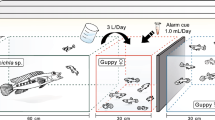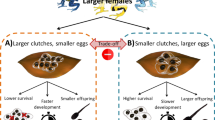Abstract
The expression of sexually-selected traits such as bright plumage, exaggerated antlers, and elongated eyestalks can be highly influenced by environmental factors, including the behaviors of mothers. Many recent studies have described the ways that maternal behavior can influence the expression of sexually-selected traits in offspring, however, few studies have investigated if and how such maternal effects might change, over time, in natural populations. Here, we examine the influence of maternal oviposition site on the expression of offspring sexually-selected traits in four successive cohorts of the heliconia bug, Leptoscelis tricolor (Hemiptera: Coreidae). Female heliconia bugs lay eggs on multiple host plant species, and offspring remain on these plants for the entirety of growth and development. We found that natal plant species had significant effects on the expression of male sexually-selected traits and the degree of sexual dimorphism. Moreover, these effects changed over time for later cohorts, concurrent with changes in host plant resources. Our results suggest that maternal effects can be a significant and dynamic influence on the sexually-selected traits of offspring. Such environmental effects on sexually-selected traits could have broad implications for the processes and outcomes of sexual selection.






Similar content being viewed by others
References
Andersson M (1986) Evolution of condition-dependent sex ornaments and mating preferences: sexual selection based on viability differences. Evolution 40:804–816
Andersson M (1994) Sexual selection. Princeton University Press, Princeton
Awmack CS, Leather SR (2002) Host plant quality and fecundity in herbivorous insects. Annu Rev Entomol 47:817–844
Bonduriansky R (2007) The evolution of condition-dependent sexual dimorphism. Am Nat 169:9–19
Bonduriansky R, Rowe L (2005) Sexual selection, genetic architecture, and the condition dependence of body shape in the sexually dimorphic fly Prochyliza xanthostoma (Piophilidae). Evolution 59:138–151
Charmantier A, Garant D (2005) Environmental quality and evolutionary potential: lessons from wild populations. Proc R Soc Lond B 272:1415–1425
Cotton S, Fowler K, Pomiankowski A (2004a) Condition dependence of sexual ornament size and variation in the stalk-eyed fly Cyrtodiopsis dalmanni (Diptera: Diopsidae). Evolution 58:1038–1046
Cotton S, Fowler K, Pomiankowski A (2004b) Do sexual ornaments demonstrate heightened condition-dependent expression as predicted by the handicap hypothesis? Proc R Soc Lond B 271:771–783
Croat T (1978) Flora of Barro Colorado Island. Stanford University Press, Stanford
David JR, Moreteau B, Gauthier JP, Petavy G, Stockel A, Imasheva AG (1994) Reaction norms of size characters in relation to growth temperature in Drosophila melanogaster: an isofemale lines analysis. Genet Sel Evol 26:229–251
David P, Bjorksten T, Fowler K, Pomiankowski A (2000) Condition-dependent signalling of genetic variation in stalk-eyed flies. Nature 406:186–188
Emlen DJ (1997) Diet alters male horn allometry in the beetle Onthophagus acuminatus (Coleoptera: Scarabaeidae). Proc R Soc Lond B 264:567–574
Emlen DJ, Allen CE (2003) Genotype to phenotype: physiological control of trait size and scaling in insects. Integr Comp Biol 43:617–634
Emlen DJ, Nijhout HF (2000) The development and evolution of exaggerated morphologies in insects. Annu Rev Entomol 45:661–708
Emlen DJ, Hunt J, Simmons LW (2005) Evolution of sexual dimorphism and male dimorphism in the expression of beetle horns: phylogenetic evidence for modularity, evolutionary lability, and constraint. Am Nat 166:S42–S68
Fujisaki K (1981) Studies on the mating system of the winter cherry bug, Acanthocoris sordidus Thunberg (Heteroptera, Coreidae): II. Harem defense polygyny. Res Popul Ecol 23:262–279
Godfray HCJ (1995) Evolutionary theory of parent-offspring conflict. Nature 376:133–138
Green AJ (2000) The scaling and selection of sexually dimorphic characters: an example using the Marbled Teal. J Avian Biol 31:345–350
Greenfield MD, Rodriguez RL (2004) Genotype-environment interaction and the reliability of mating signals. Anim Behav 68:1461–1468
Griffith SC, Sheldon BC (2001) Phenotypic plasticity in the expression of sexually selected traits: neglected components of variation. Anim Behav 61:987–993
Griffith SC, Owens IPF, Burke T (1999) Environmental determination of a sexually selected trait. Nature 400:358–360
Hughes M (1996) Size assessment via a visual signal in snapping shrimp. Behav Ecol Sociobiol 38:51–57
Jaenike J (1978) On optimal oviposition behavior in phytophagous insects. Theor Popul Biol 14:350–356
Jensen H, Svorkmo-Lundberg T, Ringsby TH, Sæther BE (2006) Environmental influence and cohort effects in a sexual ornament in the house sparrow, Passer domesticus. Oikos 114:212–224
Karan D, Morin JP, Gilbert P, Moreteau B, Scheiner SM, David JR (2000) The genetics of phenotypic plasticity. IX. Genetic architecture, temperature, and sex differences in Drosophila melanogaster. Evolution 54:1035–1040
Kelly CD (2005) Allometry and sexual selection of male weaponry in Wellington tree weta, Hemideina crassidens (Orthoptera: Anostostomatidae). Behav Ecol 16:145–152
Kodric-Brown A, Brown JH (1984) Truth in advertising—the kinds of traits favored by sexual selection. Am Nat 124:309–323
Kokko H, Heubel K (2008) Condition-dependence, genotype-by-environment interactions and the lek paradox. Genetica 132:209–216
Lande R, Kirkpatrick M (1990) Selection response in traits with maternal inheritance. Genet Res 55:189–197
Marshall D, Uller T (2007) When is a maternal effect adaptive? Oikos 116:1957–1963
Mayhew PJ (1997) Adaptive patterns of host-plant selection by phytophagous insects. Oikos 79:417–428
Mayhew PJ (2001) Herbivore host choice and optimal bad motherhood. Trends Ecol Evol 16:165–167
Miller CW (2007) Maternal effects and sexual selection in the heliconia bug, Leptoscelis tricolor (Hemiptera: Coreidae). Dissertation, Division of Biological Sciences, Ph.D. University of Montana, Missoula
Miller CW (2008) Seasonal effects on offspring reproductive traits through maternal oviposition behavior. Behav Ecol 4:482–485
Miller CW, Moore AJ (2007) A potential resolution to the lek paradox through indirect genetic effects. Proc R Soc Lond B 274:1279–1286
Mitchell PL (1980) Combat and territorial defense of Acanthocephala femorata (Hemiptera, Coreidae). Ann Entomol Soc Am 73:404–408
Miyatake T (1993) Male–male aggressive-behavior is changed by body-size difference in the leaf-footed plant bug, Leptoglossus australis, Fabricius (Heteroptera, Coreidae). J Ethol 11:63–65
Moczek AP, Emlen DJ (1999) Proximate determination of male horn dimorphism in the beetle Onthophagus taurus (Coleoptera: Scarabaeidae). J Evol Biol 12:27–37
Mousseau TA, Fox CW (1998) The adaptive significance of maternal effects. Trends Ecol Evol 13:403
Nageon de Lestang F (2010) Effects of environmental heterogeneity on male-male competitive success, size, and scaling in a cactus bug Narnia femorata (Hemiptera: Coreidae). University of Florida, Journal of Undergraduate Research, C. W. Miller, Mentor (in review)
Nur N, Hasson O (1984) Phenotypic plasticity and the handicap principle. J Theor Biol 110:275–297
Nylin S, Janz N (1996) Host plant preferences in the comma butterfly (Polygonia c-album): do parents and offspring agree? Ecoscience 3:285–289
Post E, Langvatn R, Forchhammer MC, Stenseth NC (1999) Environmental variation shapes sexual dimorphism in red deer. Proc Natl Acad Sci USA 96:4467–4471
Qvarnström A (1999) Genotype-by-environment interactions in the determination of the size of a secondary sexual character in the collared flycatcher (Ficedula albicollis). Evolution 53:1564–1572
Qvarnström A (2001) Context-dependent genetic benefits from mate choice. Trends Ecol Evol 16:5–7
Qvarnström A, Price TD (2001) Maternal effects, paternal effects and sexual selection. Trends Ecol Evol 16:95–100
Roff DA (1992) The evolution of life histories: theory and analysis. Chapman and Hall, New York
Rossiter M (1998) The role of environmental variation in parental effects expression. In: Mousseau TA, Fox CW (eds) Maternal effects as adaptations. Oxford University Press, New York, pp 112–134
Rowe L, Houle D (1996) The lek paradox and the capture of genetic variance by condition dependent traits. Proc R Soc Lond B 263:1415–1421
Scheirs J, De Bruyn L, Verhagen R (2000) Optimization of adult performance determines host choice in a grass miner. Proc R Soc Lond B 267:2065–2069
Shingleton AW, Frankino WA, Flatt T, Nijhout HF, Emlen DJ (2007) Size and shape: the developmental regulation of static allometry in insects. Bioessays 29:536–548
Stiles FG (1975) Ecology, flowering phenology, and hummingbird pollination of some Costa Rican heliconia species. Ecology 56:285–301
Sutherland ORW (1969) The role of the host plant in the production of winged forms by two strains of the pea aphid Acyrthosiphon pisum. J Insect Physiol 15:2179–2201
Teder T, Tammaru T (2005) Sexual size dimorphism within species increases with body size in insects. Oikos 108:321–334
Thompson JN (1988) Evolutionary ecology of the relationship between oviposition preference and performance of offspring in phytophagous insects. Entomol Exp Appl 47:3–14
Weladji R, Holand O, Steinheim G, Colman JE, Gjostein H, Kosmo A (2005) Sexual dimorphism and intercohort variation in reindeer calf antler length is associated with density and weather. Oecologia 145:549–555
Acknowledgments
We thank John Christy, Erick Greene, John Maron, Tom Martin, Timothy Mousseau, and Robert Fletcher for reviewing previous versions of the manuscript and for advice and support. We are grateful for dedicated fieldwork by Sonya Hollander, Enrique Espinosa, and Luke Bloch. Logistic and financial support was provided by the Smithsonian Tropical Research Institute. A National Science Foundation Graduate Research Fellowship also provided funding to C. W. M. for this project.
Author information
Authors and Affiliations
Corresponding author
Rights and permissions
About this article
Cite this article
Miller, C.W., Emlen, D.J. Dynamic effects of oviposition site on offspring sexually-selected traits and scaling relationships. Evol Ecol 24, 375–390 (2010). https://doi.org/10.1007/s10682-009-9312-6
Received:
Accepted:
Published:
Issue Date:
DOI: https://doi.org/10.1007/s10682-009-9312-6




